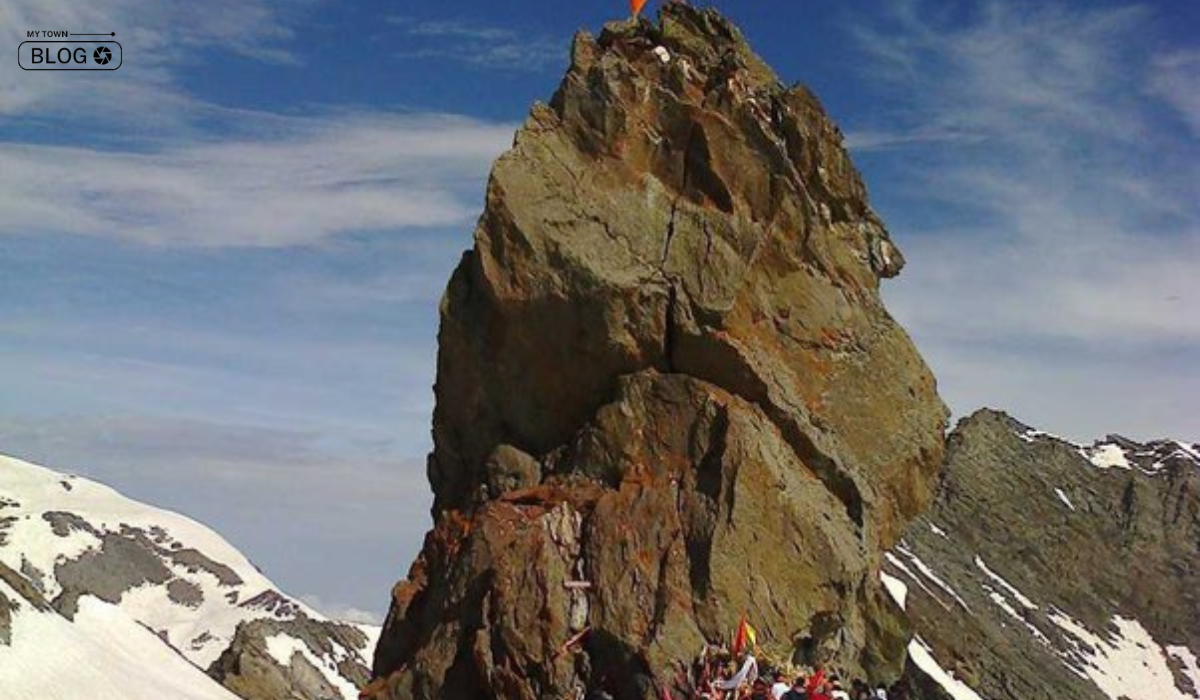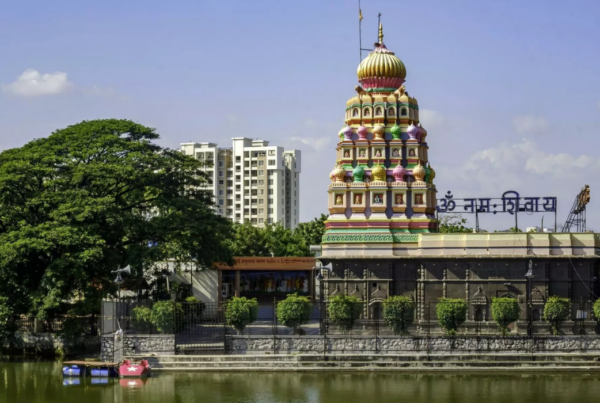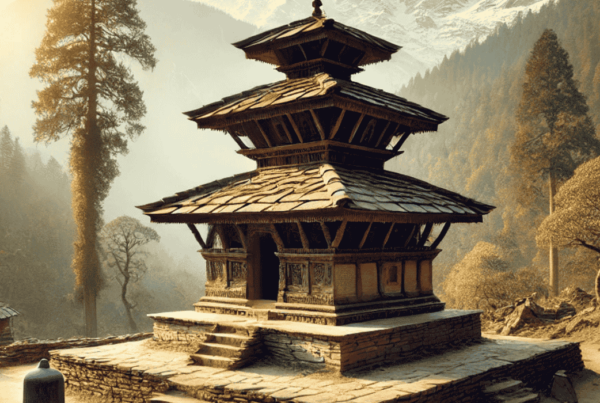The entire Himalayas is the abode of Lord Shiva, and reaching all his abodes is quite difficult. Getting to these places is challenging whether it’s Amarnath, Kedarnath, or Mount Kailash Mansarovar. In this sequence, there’s another place called Shrikhand Mahadev. While the Amarnath Yatra requires people to climb up to about 14,000 feet, reaching the Shrikhand Mahadev shrine demands ascending to an altitude of 18,570 feet.
History:
It is said that the demon Bhasmasura performed penance here and sought a boon from Lord Shiva. The boon he asked for was that whoever he touched on the head with his hand would turn into ashes. However, consumed by arrogance, Bhasmasura started chasing Lord Shiva himself. Eventually, Lord Shiva had to hide in the caves of these mountains. Parvati, out of fear of the demon, wept here. It is said that from her tears, the Nain Sarovar (Lake of Eyes) was formed here. Each drop falls from here 25 km below, covering the abode of Lord Shiva in Nirmand with a veil of divine mist. Later, Bhasmasura was slain. During the Shrikhand Yatra, people never forget to visit this lake.
Legend has it that the Pandavas spent some time here as well during their 13-year exile. The large stones arranged by Bhima show evidence of this. They also killed a demon here who used to prey on the devotees who came here.
When the demon’s blood spilled onto the ground, the earth at that spot turned red. This redness still exists there today.
People consider the history of Shrikhand Mahadev ancient, and they consider it one of the important Shiva temples in Indian religion from a religious perspective. Situated on a high point near an area of the Himalayas, the temple of Shiva Linga at Shrikhand Mahadev can be found in the Kullu district of the state of Himachal Pradesh. Most historical Puranic and religious books highlight the importance of Shrikhand Mahadev.
According to the beliefs of Lord Shiva, people consider this place a powerful pilgrimage site of Mahadev. The history of Mahadev holds great importance in pilgrimage.
Religious texts mention that in ancient times, King Dasharatha worshiped the Shiva Linga here to fulfill his desires. This led to the fame of this place as a Shiva temple. Whoever worships Lord Shiva here always receives his blessings.
The story of Shrikhand Mahadev:
Old books tell about the life of Shrikhand Mahadev, which relates to Himachal Pradesh. A story (as told in the Shiv Purana) states that at the start of the universal phase, when both demons and the gods were locked in a fierce battle, the gods came to Lord Brahma for support, together with the god-king, Indra, the Hindu Indra asked Brahma, “O Father, is it possible for us to have any hope against the demons?” Then, Brahma assured them, saying, “O King of the gods, do not worry. I will have Vishwakarma create the Vajra (thunderbolt), which will make you powerful against the demons.”
Vishwakarma then gave the gods a huge lightning that he had created. The gods started using the Vajra to battle the demons and won. After the victory, the gods, filled with enthusiasm and joy, reached Brahma. Brahma thanked them and left the Vajra at Shrikhand Mountain near Varanasi for safekeeping.
After leaving the Vajra on Shrikhand Mountain, Vishwakarma established it there, and it became famous as Shrikhand Mahadev. The gods started serving Lord Shiva and carrying out celebrations there, ultimately dedicating the Shiva Linga to Shrikhand Hill. Therefore, the legend of Shrikhand Mahadev centers around the lightning of Lord Shiva, making it an old sacred place.
Temples along the pilgrimage route:
On the route of the Shrikhand Mahadev pilgrimage in Nirmand, there are seven temples, including temples dedicated to Mata Parvati, Parashurama, Dakshineshwar Mahadev, Hanuman Temple Arasu, Jotakali, Bakasura Vadha, Dhank Dwar, and several other holy places.
The Shrikhand Mahadev Trust organizes the pilgrimage, which begins in July. This trust has facilitated several health and safety measures in collaboration with the administration. They set up camps in Singhgad, Thachdu, Bhim Dwar, and Parvati Bagh. Singhgad offers registration and medical check-up facilities, while accommodation facilities are available at various locations.
The camps deploy doctors, police, and rescue teams. The pilgrimage comprises three stages: Singhgad, Thachdu, and Bhim Dwar.
The Shrikhand Mahadev Cave:
The Shrikhand Mahadev below-ground temple in Himachal Pradesh is a very sacred place for devotees of Lord Shiva. There are mountains nearby of Shrikhand Mahadev’s beautiful cave. To receive the blessings of Shrikhand Mahadev, people enter the cave. Under the cave is a Shiva Linga, called Shrikhand Mahadev. The specific altitude of Shrikhand Mahadev’s tunnel is 5,334 meters or 17,500 feet. Every year, thousands of people travel here to receive Mahadev’s blessings.
Beliefs associated with the place:
According to local belief, it was here that Lord Vishnu obtained a boon from Lord Shiva to allow Bhasmasur to perform the dance. While dancing, Bhasmasur inadvertently placed his hand on his own head, turning himself into ashes. People believe that this is the reason why the soil and water here still appear red from a distance.
Parvati Bagh:
During the journey, Parvati Bagh also falls on the way. People associate it with Mother Parvati. Colorful flowers still bloom here.
These flowers find no other place but this one. This 32-kilometer-long journey is laden with snowy and herb-laden mountains. The air here is cool and enchantingly fragrant. Devotees worship Lord Shiva and continue on the Sankarayana path.
The main pilgrimage route to reach Shrikhand Mahadev:
From Rohru to Shrikhand Mahadev:
The Shrikhand Mahadev pilgrimage begins in a place called Bimdra, located near the village of Rohru. Travelers can start their journey from here. The journey from Rohru to Shrikhand Mahadev involves trekking and endurance. During the journey, you need maximum patience and strength.
From Bhaskaru to Shrikhand Mahadev:
Bhaskaru is also an option for the Shrikhand Mahadev pilgrimage. The journey from Bhaskaru also involves trekking and endurance. This journey can also be challenging, requiring physical and mental preparedness.
During the journey, you should gather information about the pilgrimage from local administration or organizations and follow their instructions. You should prepare appropriately for the journey, including rest, food, and necessary equipment. During the journey, you will have the opportunity to enjoy the beautiful mountain scenery.
Frequently Asked Queries (FAQs):
Where is Shrikhand Mahadev’s place of residence?
Named for Lord Shiva, Shrikhand Mahadev is a well-known tourist destination in the Kullu district of Himachal Pradesh, India.
What role does Shrikhand Mahadev take on?
While followers seeking benefits love and honor Shrikhand Mahadev, considers it the home of Lord Shiva, and connects it to stories of mythology.
What is the trek taken by travelers to reach Shrikhand Mahadev?
The main route starts from Rohru or Bhaskaru and involves a challenging trek through Singhgad, Thachdu, and Bhim Dwar, with facilities like camps and temples along the way.
Where is the Shrikhand Mahadev temple held?
The Foundation arranges the trek, which usually starts in July and demands mental as well as physical preparation due to the challenging conditions.
What amenities are offered to tourists while they travel?
On the way, the Organization provides camps with a place to stay medical care, and certification to make sure travelers are safe.
When traveling on the Shrikhand Mahadev journey, what should travelers plan for?
Travelers need to maintain their health and take what they need to prepare for tough trekking situations, high elevations, and unpredictable weather.
Which myths and stories are connected to Shrikhand Mahadev?
The traditions of Lord Shiva, the Hindu God Vishnu, and the monster Bhasmasura are part of the local views, which contribute to the spiritual importance of Shrikhand Mahadev.
Is the religious journey appropriate for all people?
The journey might not be right for everybody due to its asking for nature. Before starting their journey, travelers should evaluate their health and speak with experts.
What can someone take to join in the Shrikhand Mahadev journey?
Interested individuals can obtain details from the local government or travel agents and make plans while following safety protocols and readiness measures.
Also Read: Kinner Kailash Trek: History, Trek Permit, Tracking Tips, And How To Reach








